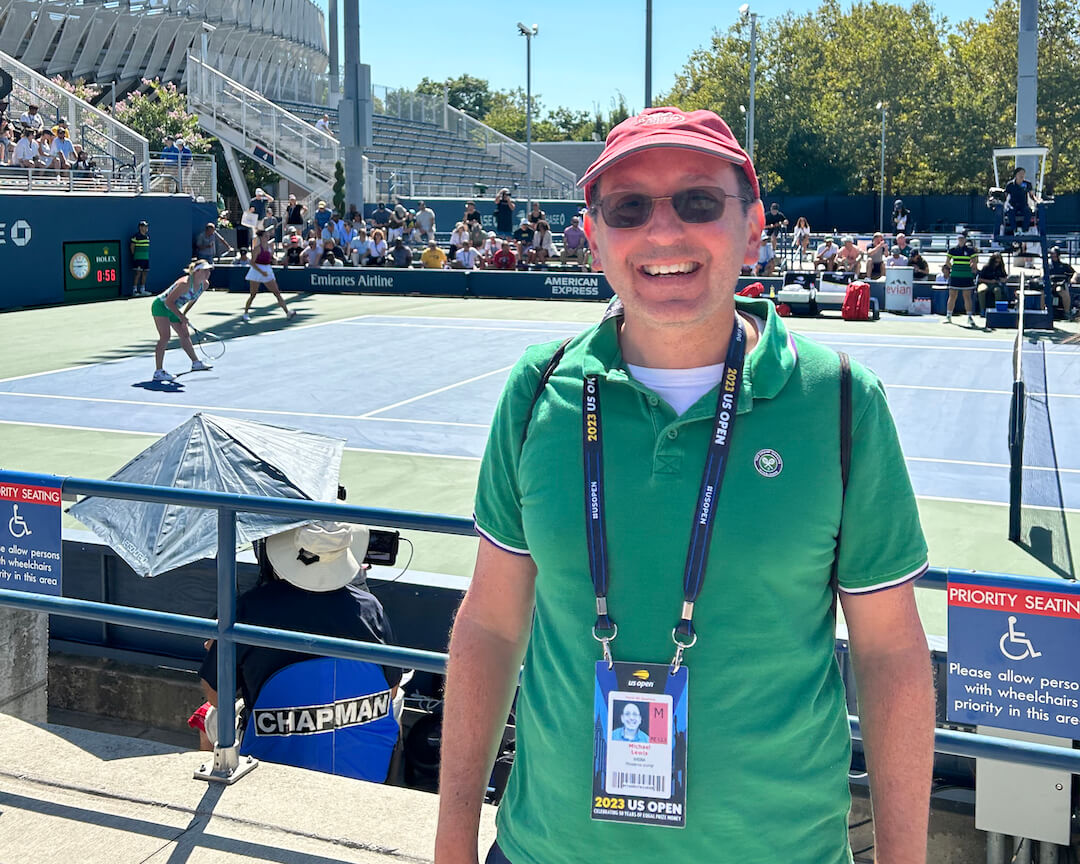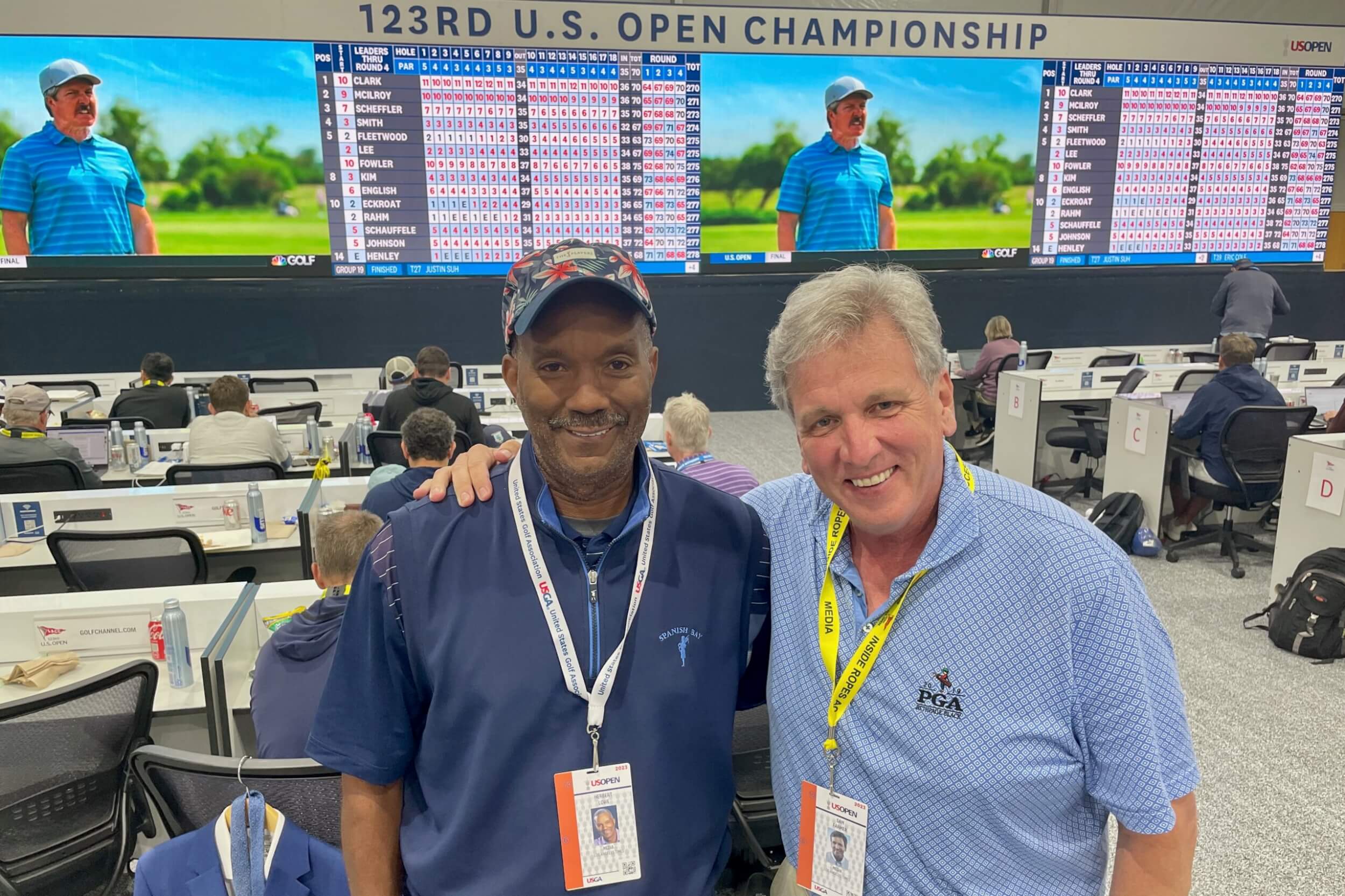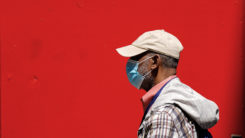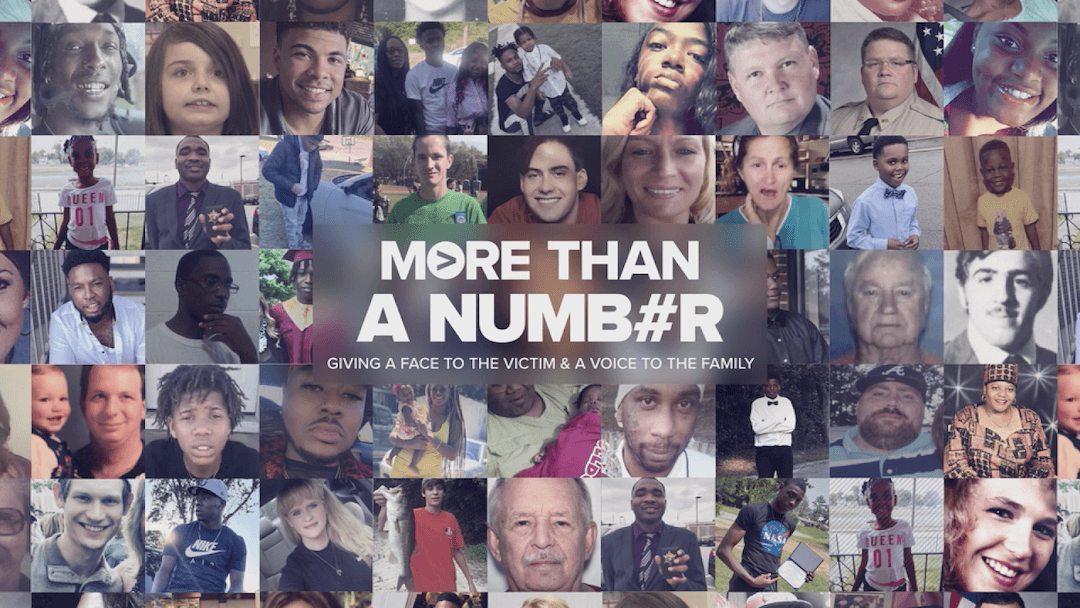Michael J. Lewis annually covers the U.S. Open, professional tennis’ fourth and final grand slam of the year. The Providence Journal puts in for — sponsors — his credential. Once among the throngs in Queens, New York, Lewis could also be writing on deadline for The Kansas City Star. Or The Cincinnati Enquirer. Or a small paper in Wisconsin that will only remember to pay him when snow hits the ground.
Should a Rhode Island story emerge, Lewis can pitch Bill Corey, the Journal’s sports editor. If Corey is game, Lewis will add it to the Word doc of assignments and leads that resides in his email. This is what will keep a one-man news service humming for three weeks.
Every August, Lewis pores over the Open’s participants — players in qualifying rounds, juniors — to see who’s playing and where they live. Then he matches players’ hometowns or colleges to local papers and promotes his strengths: He lives in Port Washington, New York, a 30-minute train ride to the USTA Billie Jean King National Tennis Center in Queens. An editor doesn’t have to pay for travel or rely on just-the-facts, ma’am wire copy — if there is any. He’s experienced. And he works cheap, which he stresses in his pitch. Last year, Lewis wrote 13 stories for nine papers and earned a little shy of $1,100 in addition to covering the Open’s juniors tournament for the International Tennis Foundation.
He guesses the least he’s made for a story is $35; the most, between $200 and $250. He usually gets between $50 and $100. A day can start between 10 and 11 a.m., and get him home close to 11 p.m., when his two children, soon-to-be 9-year-old Nate and 5-year-old Theo, fully reside in dreamland.
Lewis’s close friend is Jeff Pearlman, a University of Delaware classmate and the New York Times best-selling sportswriter (“Showtime,” “The Last Folk Hero”). Pearlman often texts Lewis during his Flushing Meadows residency.
Here’s a typical exchange, according to Lewis.
Pearlman: Where are you?
Lewis: I’m at Court 12.
Pearlman: How much are you getting paid for this?
Lewis: $50.
Pearlman: How many words are you going to write?
Lewis: Probably 700.
Pearlman: You’re going to write 700 words about this? You’re crazy.
“But I don’t think he’s crazy at all,” Pearlman clarified. “He’s doing what he loves.”
***
Lewis, 48, a freelance writer and book editor, is a stay-at-home dad. When we talked in late July, he was making a snack for Theo, who had just returned from camp. (Lewis’s wife, Shelley, works in finance.) In summer 2011, after 15 years in newspapers, interrupted by a “disastrous” 18-month stint at the basketball magazine SLAM, Lewis was tired of dwindling opportunities and sweating layoffs. He left The Daytona Beach News-Journal to get a teaching degree from a one-year advanced program at Queens College.
That turned out to be a short-lived career — the world didn’t need another English teacher — but moving back to New York had its benefits. For one thing, he could attend the U.S. Open again.
The self-described “tennis freak” was perusing the tournament’s qualifying results in August 2011 when he stopped cold. He had profiled a young tennis phenom named Reilly Opelka in Daytona Beach. Lewis thought nothing of it — until he saw Opelka had qualified for the Junior U.S. Open. Lewis convinced the News-Journal to let him cover the story; the U.S. Open gave him a one-day press pass. It was fun.
Two years later, Lewis, sans credentials, attended the Open’s qualifying tournament a week before the main draw to look for angles. Jared Donaldson was from Providence, Rhode Island, a city with little tennis history. That felt like a story people would want to read. The Providence Journal agreed. With no public relations hurdles to clear, Lewis interviewed Donaldson with the ease of Patrick McEnroe snagging Rafael Nadal at Wimbledon.
Other papers, Lewis thought, would pay $75 for something similar.
Since 2014, save for the 2020 COVID-19 pandemic, he has done that in earnest. Some years are busier than others, but he’s developed relationships. One is with Pierre Tristam, Lewis’s former News-Journal colleague, and the editor at Florida’s FlaglerLive. Opelka, who turned 26 on Aug. 28 and is nearly 7 feet tall, has won four ATP singles titles and was ranked in the top 20 last year. Opelka’s connection to the Palm Coast and FlaglerLive’s lack of a sports desk created a niche for Lewis, whom Tristam calls “a lifesaver.”
“He’s a pro, knows what the good stories are and how to get them, no hand-holding necessary,” Tristam wrote in an email. “I don’t think that’s the norm in journalism anymore, with so many younger reporters lacking newspaper training or an instinct for initiative. So FlaglerLive’s been very fortunate.”
Lewis is, too. “I get to watch tennis for three weeks,” he said. His wife’s job allows Lewis to embrace that approach and not focus on fees, but he is acutely aware that he’s not attending a sports journalism summer camp. Lewis sometimes watches as many as four matches a day, and not because a deadline is imminent. He’ll attend matches and press conferences as prep work should a player advance, prompting an outlet to want coverage.
That the number of tennis reporters in American media has dwindled while Lewis updates multiple editors hasn’t made him cocky. He still has a mentality that he doesn’t belong, so he usually heads to the back of the media center with the foreign press. Lewis also never attends the men’s and women’s championship matches — it’s not part of his job. He chronicles the overlooked and the embryonic talents, including a pre-superstardom Jessica Pegula and Coco Gauff. He finds the gem of a human interest story, like how JC Aragone, who attended the University of Virginia, was in a coma for three weeks in 2012.
“My hope each year,” Lewis said, “is the players I’ve got a good rapport with don’t get too good.” Once they reach the top 30, the access vanishes; wire copy and national outlets make him irrelevant. At that point, their parents have probably stopped hanging framed articles on the living room wall.
That’s OK. Lewis has no desire to grind 40 weeks a year on the tennis tour, missing out on life. Nate and Theo know they won’t see Daddy much from Aug. 22 to Sept. 10. But he will be around the other 49 weeks.
***
After the adrenaline rush of deadlines and preparation, he is loopy, exhausted. A few writers, Lewis said, do this, notably Adam Zagoria, whom he calls “a more successful me.” But there’s a reason it’s a few and not a crop. “It’s just way too much energy and effort to put in for the little reward,” Lewis said.
Pearlman doesn’t see it that way. He has extolled Lewis’s approach several times, most recently on his popular journalism Substack.

Freelance journalist Michael J. Lewis covers the 2023 U.S. Open. (Courtesy: Michael J. Lewis)
“Nowadays, everyone thinks their first stop should be The Washington Post or ESPN or The New York Times, and the truth is that’s really hard. It’s also out of your control,” Pearlman wrote via Twitter/X direct message. “But busting ass is not. You can outwork, outhustle, outgun everyone and make yourself known. Lew is the benchmark for that. He’s not trying to be famous and climb the ranks at this stage in his life, but he works like he is.”
Lewis does a similar kind of outreach for college basketball, his other passion. “Around March Madness and preseason tournaments, I’ll pitch, ‘Oh, Baylor is coming to Madison Square Garden’ to the Baylor paper.” (Corey, the Providence Journal sports editor, frequently receives these types of pitches. “Freelancers, in my mind,” he said, “have become much more sophisticated than they have in the past.”) The U.S. Open and March Madness being six months apart is a professional and personal reprieve for Lewis. According to her husband, Shelley Lewis jokes that their marriage “might not survive if they were back-to-back.”
That Lewis, or any freelance sportswriter, lands assignments is itself a small miracle.
Corey said a freelancer like Lewis “who has experience, who is able to deliver, who can hit deadlines, is more valuable now than ever.” That doesn’t mean an editor can hire one when the need arises. Every sports section has what Naila-Jean Meyers, senior assistant sports editor for The Star-Tribune in Minneapolis, describes as a “calculus” for using freelancers.
An editor has to have money in the budget. There has to be room in the paper’s coverage in late August and early September. One of Lewis’s biggest obstacles is that the U.S. Open runs when high school football starts in most of the country.
“We mostly use our freelance budget, to be honest, to cover high school sports,” Meyers said. “Prep sports is such a big field here you can almost never have enough people writing about it.” The event has to be big enough to cover in person rather than remotely. The COVID-19 pandemic, Meyers said, hurt freelancers because “we realized there’s a lot we can do from here” and “well enough that our readers are served.”
Matt Pepin, the sports editor at The Boston Globe, said a major factor behind spending money for travel is if a story involves one of its big four pro teams — the New England Patriots, the Red Sox, the Bruins, or the Celtics. “That’s the subject area that our readers are the most interested in,” Pepin said. As Meyers explained, money not spent today could be used to travel to report tomorrow’s nuanced feature that’s perfect for the community. If a beat writer can cover an extra assignment on the road or an intern attends college near where a local star athlete will be feted, those are other options. It’s easy, Meyers admitted, when there’s no money for freelancers: “Then you don’t have to have a thought experiment.”
There are ways to slip through. Freelancers who pitch Pepin in July or August, when the Globe’s sports coverage slows, will have a better chance of hearing yes than in June or October. And it helps if the subject is from New England instead of someone who attended college there or played with a local team for a spell.
Corey tries to remember that “maybe not everybody is as interested in high school football as we are.” If there’s an interesting story involving a local person, resources should be steered toward that. A general story on the U.S. Open is a no-go, but a story on a line judge from Providence has a shot. “That’s something,” he said, “you’re not going to get on the wires and that probably does have an audience.”
Hope, a freelancer’s indefatigable partner, always says yes. When Lewis started offering his services in mid-August, he grew excited. A few outlets he had struck out with in years past had new editors. Maybe, he thought, they’ll be more inclined to let me cover the Open.
Pepin, who has not worked with Lewis, expressed reservations about a freelance writer balancing that amount of deadline-oriented work, leaving his desk possibly waiting for copy.
Corey, though, is fine with it. He knows one article for the Journal won’t pay the bills.
“As long as he gets done what I need him to get done on the deadline we agreed to, what he does for other publications is really up to him, and it’s not my concern,” Corey said. It’s never been apparent, he added, that Lewis is juggling multiple Open deadlines. This year, Lewis covered a match for three different outlets at the same time, a first for him.
“Honestly,” Pepin said, laughing, “I don’t know how he does it.”
***
So, why does he do it?
Why does he try to seduce editors who can seem capricious for a fee that, if he’s lucky, might take care of that week’s grocery list? Why does he endure late nights in muggy Queens watching an anonymous pro serve and volley their way out of oblivion? Or play schedule Tetris on days with multiple matches?
“I love this tournament and tennis so much,” Michael J. Lewis said. “I want people to get hooked.”
The words tumble out.
“It’s chaotic; it’s crazy,” he said. “There’s so much going on. There’s always a good match no matter when you go. There’s always a chance to see something you’ve never seen before. I might see a kid from Belarus. I might see a kid from Africa. It’s a smorgasbord of the sport I love. It’s 200, 300 players all playing within a few days.”
And it’s a bargain.
“I don’t buy $400 tickets to sit courtside at the Knicks. I don’t spend $1,000 to see the Rangers. You can go and see the greatest players in the world right in front of you for less than $100.”
Lewis can’t be bothered by professional annoyances, let alone the slow walkers and self-obsessed cellphone users when he is immersed in a “lovefest of tennis” right in his backyard. Lewis’s employer changes. He remains exactly where he wants to be.







Comments